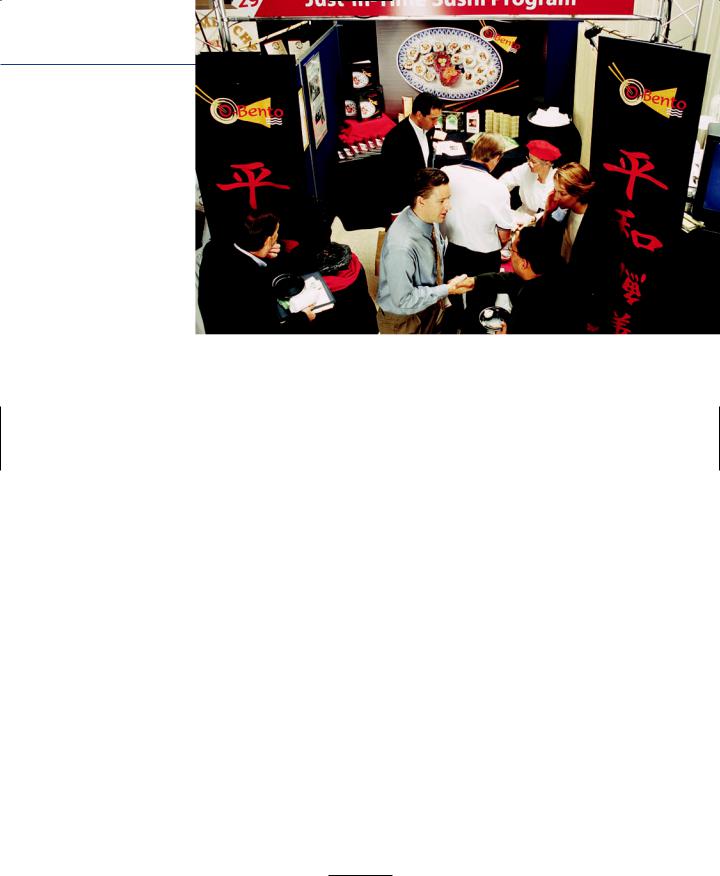
- •CONTENTS
- •PREFACE
- •Content—Benefits for Students
- •Content—Benefits for Instructors
- •Features of the Book for Students and Instructors
- •Supplementary Materials
- •Acknowledgments
- •What Is Hospitality Management?
- •The Manager’s Role in the Hospitality Industry
- •Why Study in a Hospitality Management Program?
- •Planning a Career
- •Employment as an Important Part of Your Education
- •Getting a Job
- •Employment at Graduation
- •The Outlook for Hospitality
- •Summary
- •Managing Change
- •Demand
- •Supply
- •Workforce Diversity
- •The Impact of Labor Scarcity
- •Summary
- •The Varied Field of Food Service
- •The Restaurant Business
- •The Dining Market and the Eating Market
- •Contemporary Popular-Priced Restaurants
- •Restaurants as Part of a Larger Business
- •Summary
- •Restaurant Operations
- •Making a Profit in Food Service Operations
- •Life in the Restaurant Business
- •Summary
- •Chain Restaurant Systems
- •Independent Restaurants
- •Franchised Restaurants
- •Summary
- •Competitive Conditions in Food Service
- •The Marketing Mix
- •Competition with Other Industries
- •Summary
- •Self-Operated Facilities
- •Managed-Services Companies
- •Business and Industry Food Service
- •College and University Food Service
- •Health Care Food Service
- •School and Community Food Service
- •Other Segments
- •Vending
- •Summary
- •Consumer Concerns
- •Food Service and the Environment
- •Technology
- •Summary
- •The Evolution of Lodging
- •Classifications of Hotel Properties
- •Types of Travelers
- •Anticipating Guest Needs in Providing Hospitality Service
- •Service, Service, Service
- •Summary
- •Major Functional Departments
- •The Rooms Side of the House
- •Hotel Food and Beverage Operations
- •Staff and Support Departments
- •Income and Expense Patterns and Control
- •Entry Ports and Careers
- •Summary
- •The Economics of the Hotel Business
- •Dimensions of the Hotel Investment Decision
- •Summary
- •The Conditions of Competition
- •The Marketing Mix in Lodging
- •Product in a Segmented Market
- •Price and Pricing Tactics
- •Place—and Places
- •Promotion: Marketing Communication
- •Summary
- •The Importance of Tourism
- •Travel Trends
- •The Economic Significance of Tourism
- •The United States as an International Tourist Attraction
- •Businesses Serving the Traveler
- •Noneconomic Effects of Tourism
- •Summary
- •Motives and Destinations
- •Mass-Market Tourism
- •Planned Play Environments
- •Casinos and Gaming
- •Urban Entertainment Centers
- •Temporary Attractions: Fairs and Festivals
- •Natural Environments
- •On a Lighter Note. . .
- •Summary
- •Management and Supervision
- •The Economizing Society
- •The Managerial Revolution
- •Management: A Dynamic Force in a Changing Industry
- •What Is Management?
- •Summary
- •Why Study Planning?
- •Planning in Organizations
- •Goal Setting
- •Planning in Operations
- •The Individual Worker as Planner
- •Long-Range Planning Tools
- •Summary
- •Authority: The Cement of Organizations
- •Departmentalization
- •Line and Staff
- •Issues in Organizing
- •Summary
- •Issues in Human-Resources Management
- •Fitting People to Jobs
- •Recruiting
- •Selection and Employment
- •Training
- •Retaining Employees
- •Staff Planning
- •Summary
- •The Importance of Control
- •Control and the “Cybernetic Loop”
- •Tools for Control
- •Summary
- •Leadership as Viewed by Social Scientists
- •Why People Follow
- •Leadership Theories
- •Communication
- •The Elements of Leading and Directing
- •Developing Your Own Leadership Style
- •Summary
- •A Study of Service
- •Rendering Personal Service
- •Managing the Service Transaction
- •How Companies Organize for Service
- •Summary
- •INDEX

GLOBAL HOSPITALITY NOTE 7.1
International Perspectives
Although the discussion of on-site food service in this chapter is primarily limited to examples in the United States, this should in no way imply that such operations are limited to this country. Companies, hospitals, colleges, and so on in every part of the world have provided food service to their associates/ students/customers for a very long time. One look at the top food service management companies in this sector in North America indicates just how truly international this market is. Current leaders, are ARAMARK, Sodexho, and Compass Group. Sodexho (www.sodexho.com) is a French-based company that has had a presence in the United States since the mid-1980s. The Compass Group, (www.compass-usa.com), which operates several subsidiaries including Canteen and Chartwells, is based in England and operates in over 45 countries worldwide. Finally, perhaps the best example of ARAMARK’s (www.aramark.com) international expertise is its long involvement with providing food service for the Olympics. The company most recently provided the food service for the 2004 Summer Olympics in Athens. ARAMARK also manages a variety of services around the globe—in 18 different countries, to be exact.
varying the menu for a guest who must eat in the same place for weeks, months, or even years at a time can be a demanding task.
There are many other differences that exist between the two segments as discussed throughout this chapter. One major distinction that students should keep in mind is the international reach of some of the major companies in this sector, as discussed in Global Hospitality Note 7.1. Further distinctions are discussed next as we examine the two primary types of operations.
Self-Operated Facilities
Many institutions see no reason to pay to a contract company the overhead and profits that they could potentially garner. This attitude is perhaps most prevalent in primary/secondary school feeding and in health care, where many institutions still
operate their own food service facilities. Operating on the assumption that their own employees can manage as efficiently as a contract company can, these institutions choose to keep the overhead and profit they otherwise would have to pay to an outside company. As a result, these institutions can more directly control their operations, and to some extent, they can limit the staff turnover traditionally associated with man- aged-services companies, which frequently promote or transfer their employees. “If we
193

194Chapter 7 On-Site Food Service
like a person,” said one university official, “we might lose him to a contract company. In our own operation, if we treat him right, we have a good chance of keeping him—of maintaining staff stability.” There are some very unique characteristics of self-operated units, not the least of which are related to human resources. The number of self-operators is decreasing, however, as institutions begin to focus more on their core functions and as managed-services companies continue to gain market share.
Managed-Services Companies
Managed-services companies (or contract management companies), on the other hand, feel that their method of operation offers advantages to institutions of all sizes. True, unit managers may be, and are, transferred. We should note, how-
ever, that a contract company provides the client with two kinds of managers: the unit manager and the regional and district managers who train, evaluate, and supervise the unit manager’s work and ensure management continuity. That continuity is an important offset to the possibility of transfer. Perhaps even more important, the transfer is part of a process of career progression. People who want to advance are drawn to that kind of opportunity. Thus, a contract company is likely to attract aggressive managers. Managers who choose to stay with institutional operators are likely to have less opportunity for advancement, although they will have other advantages, such as stability in where they live.
Another area in which managed-services companies offer advantages is that of purchasing. Selection of the best, most cost-effective purveyor offers major potential for savings. So does knowledgeable negotiation on the client’s behalf by national buyers with broad experience. Contract companies conduct audits of cost-plus suppliers’ books to ensure accurate billing, an expenditure of effort and money that might not be practical for an individual client. Finally, because contract companies buy on a regional or national scale, they can consolidate purchasing for several clients, thus achieving significant economies. In recent years, however, institutional operators have made moves that can offset this advantage by forming cooperative buying groups and passing the volume discount advantages on to the member institutions.
Managed-services companies also offer to their clients, at cost, extensive facilities planning services. These services include operational design (equipment), interior design, procurement, supervision of construction, and equipment installation. Specialized accounting and market planning services may also be offered to clients.
Finally, contract companies offer the collective experience of management and marketing in many markets. Marketing programs can be tailored to individual clients,

Managed-Services Companies |
195 |
TABLE 7.1 |
|
Ten Largest Managed-Service Companies |
|
Compass Group—North America |
www.compass-group.com |
Sodexho |
www.sodexho.com |
ARAMARK |
www.aramark.com |
Delaware North Companies |
www.delawarenorth.com |
Centerplate |
www.centerplate.com |
AVI Food Systems, Inc. |
www.avifoodsystems.com |
Guest Services, Inc. |
www.guestservices.com |
Guckenheimer Enterprises |
www.guckenheimer.com |
Xanterra Parks and Resorts |
www.xanterra-coporate.com |
Thompson Hospitality Services |
www.thompsonhospitality.com |
for instance, yet also draw on national marketing programs developed by the contractor. This has proved especially helpful in areas such as nutritionally oriented marketing programs. The top ten managed-services companies are identified in Table 7.1.
PROS AND CONS OF MANAGED SERVICES
To all of this, the large institutional operator will likely respond that a sizable institution (medical center, university, or school district) is big enough to achieve most or all of these advantages on its own. A smaller institution might add that voluntary buying co-ops and judicious use of consultants can also achieve a good part of these effects. Both would emphasize that the institution is able to retain full control over the operation, which reports directly to the institution’s top management.
No doubt, contract companies would make responses to each of these points. Our purpose is not to settle the issue in any final way or to suggest that one approach is “better” than the other. There really is no one answer to the debate. What we want is to suggest the outlines of the competition between institutional operator and managedservices company for consideration by the reader.
The contract companies’ share is substantial and growing in most segments. Although exact figures are difficult to determine, Table 7.2 shows that contract food service companies currently manage a significant number of on-site food services.
Health care is one area in which contract companies have relatively low market penetration, but even this area is increasing as a result of health care facilities wishing to outsource their food service, and other support services, in an effort to focus

196 |
Chapter 7 On-Site Food Service |
TABLE 7.2 |
|
|
The On-Site Food Service Market |
|
|
|
ESTIMATED SIZE OF |
DEGREE OF |
|
TOTAL MARKET |
PENETRATION |
|
(NUMBER OF |
BY CONTRACT |
|
ACCOUNTS)a |
COMPANIESb |
Business and industry |
36,367 |
80–85% |
Colleges and universities |
3,541 |
60–65% |
Hospitals |
6,806 |
45–50% |
Primary and secondary schools |
84,422 |
20–25% |
Total |
131,136 |
|
aInternational Foodservice Manufacturers Association.
bDennis Reynolds, On-site Foodservice, John Wiley & Sons, 2003.
on their core function—care for patients. Contract companies have also had success with public schools in recent years. The two areas in which the contract companies are well established are colleges and universities and business and industry. Each of the four major divisions within on-site food services has unique characteristics. Moreover, the factors that affect the outlook for each vary. We will consider each of them briefly.
Business and Industry Food Service
Business and industry (B&I) food service provides food for the convenience of both the guests (the company associates) and the client (the employer).
The client wants inexpensive food with enough variety and quality to satisfy the associates, as the client knows that food can directly affect morale. Quick service is also important, because the time for coffee breaks and lunch is limited. Finally, it is in the best interest of most companies to keep their employees on the premises during food service breaks.
Two of the underlying forces that drive the B&I market are the size of the workforce and the level of employment. The size of the workforce affects the long-term outlook. When it was growing, during the years when the baby boomers were leaving school and entering employment, the workforce was a strong positive force. Now that the surge is over, however, the Bureau of Labor Statistics estimates that the workforce will increase at a more modest rate. To put this into perspective, there are approximately 145 million employed workers in the United States, and this figure has slowly risen since 2002 (from

The business and industry food service segment continues to experience growth partially due to innovative new services and concepts. (Courtesy of Sodexho.)
135 million). Within the workforce, the trend is toward an economy increasingly dominated by service industries that employ more office and white-collar employees. The volume of food service in commercial and office buildings is growing at a significantly faster pace than it is in manufacturing plants. In periods of relatively low unemployment (about 5 percent), such as is the case currently, B&I volume may rise. On the other hand, B&I is especially sensitive to downturns in employment.
In recent years, the telecommunications, computer and automotive industries have all lost many thousands of jobs and this has affected the food service operations servicing these industries. Recent downsizings have caused companies to take a close look at their food service operations and to take the necessary measures to streamline them and, increasingly, outsource them. The National Restaurant Association indicates that business and industry sales (managed by contract companies) experienced slow but positive growth between 2004 and 2005, while independent operators experienced negative growth during that same period.1 Cuts at banks (including the Federal Reserve Bank of New York) have resulted in having to reduce food service staff and rethink service strategies.
Business and Industry food service is also increasingly feeling the effects of outside competition from restaurants. Even with the limited time available, employees may choose to go off-site for their meals. When one considers that the majority of businesses are located near malls, industrial centers, city centers, and the like, one realizes the number of dining options that are available to employees.
All is not doom and gloom for this segment, however. Difficult times have resulted in opportunities for both managed-service companies as well as self-ops and, as a
197

198Chapter 7 On-Site Food Service
result, they are becoming much more creative in their approaches. Each of the four major on-site segments is combating these competitive forces in its own way, but the B&I segment has been one of the most aggressive. One very effective strategy that man- aged-services companies, in particular, have adopted has been to develop food service concepts or brands of their own or to use established commercial franchise brands. ARAMARK’s strategy has been to develop its own brands, such as Gretel’s Bake Shop, Itza Pizza, El Pollo Grande, and Leghorn. Likewise, Compass Group, North American Division, offers Ritazza Coffee, Not Just Donuts, and Upper Crust (sandwiches) of its own. Brand-name units are themed much like any other chain operation, and the brand is promoted within the client’s establishment. ARAMARK finds a high level of consumer acceptance for their brands, as evidenced by large increases in sales in units where they are established. The other advantage is that no franchise royalties are paid. This results in savings that can be passed on to both guest and client. ARAMARK also makes extensive use, however, of major national franchise brands, as does Sodexho, which has partnered with franchise brands such as Pizza Hut and Nathan’s Famous. Other brands that have partnered with managed-services companies include Wendy’s, Little Caesars, Dunkin’ Donuts, I Can’t Believe It’s Yogurt, Chick-fil-A, and Starbucks, among many others.
The advantages of the brand-name specialty restaurant format, whether the brand is proprietary or franchised, are startlingly similar to the advantages that food service has in the commercial restaurant business.
■The operation has an identity that helps secure patronage from an increasingly brand-conscious food service customer.
■The facility is simpler to build than is a full-menu concept, and the investment required can be significantly less.
■Operating costs are lower, too, because of the simpler menu and because customers are accustomed to self-busing in fast food.
■Fast food is fast—in-plant feeding at General Motors plants takes only 3 minutes, compared with 12 minutes under earlier formats.
One of the most important considerations when introducing a branded concept is the expected increase in the participation (or capture) rate. Other techniques for increasing the participation rate are described in Industry Practice Note 7.1.
The purpose of employee food service operations changes, however, with different employee levels. Many companies maintain executive dining rooms boasting fancy menus and elegant service. Such dining rooms are often used to entertain important

INDUSTRY PRACTICE NOTE 7.1
Measuring Guest Participation
In the commercial food service sector, most activity is driven by sales and vice versa. In on-site food service, whether self-operated or overseen by a management company, the critical factor is the participation (or capture) rate. If company associates, college students, and so forth choose not to participate in the on-site food service, neither the client nor the food service operator will be satisfied. This holds true whether the facility is located in a hospital, ballpark, university, or industrial park.
Food service operators go about managing the participation rate in a variety of ways. One thing is for certain, however—more and more, the strategies that managers are employing closely resemble those used by managers of commercial operations. New services, positioning, branding, quality, attractive pricing, providing innovative menus, offering variety, and merchandising are but a few of the ways that managers attempt to influence the participation rate of guests.
Not too long ago, it would have been hard to imagine being able to order upscale Chinese food in the company cafeteria, find a food court in a hospital, or order a microbrewed beer at the ballpark. Yet with operators focusing ever more attention on customizing their products and services to meet the desires of customers, the battle over participation rate will rage on.
business guests—customers, prospective employees, the press, and politicians. Executive dining room privileges can also be an important status symbol among managerial employees. Further, even though tax law changes have generally lowered the rate at which business meals may be deducted (to 50 percent), meals served to employees at their place of work remain 100 percent deductible under certain conditions. Clearly, there are several legitimate reasons that speak to providing meals to line employees as well as executives.
Some companies (self-ops), such as SAS, Corning, and MCI just to name a few, take their employee food service programs very seriously. SAS attributes its employee loyalty, at least in part, to its food service program. Food service at the company headquarters includes three cafeterias, day care feeding, break centers, and extensive catering. In 2003, the company earned $1 million in revenues (partially subsidized by SAS).2
Many of the changes that are occurring in this segment are driven by host companys’ increasing emphasis on the bottom line. As a result of this, more and more companies are outsourcing the management of their food service operations to management companies. Recall from Table 7.2 that penetration in this segment is the highest of any of the four primary segments (over 80 percent). This has boded well particularly for the big-three contract management companies (ARAMARK, Compass, and
199
